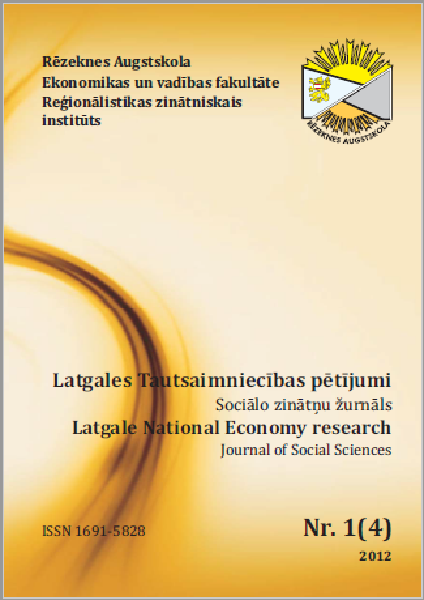DEVELOPMENT OF TOURISM IN LATVIA: ISSUES AND POTENTIALITIES
DOI:
https://doi.org/10.17770/lner2012vol1.4.1833Keywords:
Baltic States, development „ foreign tourists, Latvia, tourismAbstract
Tourism is recognized as one of the most important economic sectors or industries in the world and many countries see tourism as the main instrument for economic and regional development. The paper provides a short theoretical framework for tourism and its role or impact, discussing the definition of tourism and some aspects of the tourism sector. The paper presents results of studies devoted to some issues of tourism development in Latvia. Comparison of some indicators of tourism sector’s development between the Baltic States is presented. The results show that long–term development of Latvia’s tourism sector is less successful than in other Baltic States, particularly in Estonia. The trends of Latvia’s tourism sector development are indicative of recovery from crisis (2008–2009). Besides, opinions and impressions of foreign tourists have been analyzed with an aim to recognize the most important issues hampering the foreign tourists’ flow to Latvia.Downloads
References
BAGGIO, R. Symptoms of complexity in a tourism system. Tourism Analysis.
Vol. 13, Issue 1, pp. 1–20.
BAGGIO, R., SCOTT, N., COOPER, C. Improving tourism destination governance:
a complexity science approach. Tourism Review. 2010. Vol. 65, Issue 4, pp. 51–
CENTRAL STATISTICAL BUREAU OF LATVIA (CSB) databases. Accessed:
http://data.csb.gov.lv/Dialog/statfile1.asp
Components and Elements of Tourism. 2011. Accessed:
http://codis4u.wetpaint.com/page/Components+%26+Elements+of+Tourism
CREACO, S., QUERINI, G. The role of tourism in sustainable economic
development. 43rd Congress of European Regional Science Association, 27.
August – 30. August 2003, Zagreb. 17 p.
Definition of tourism. World Tourism Organization. Accessed:
http://torc.linkbc.ca/torc/downs1/WTOdefinitiontourism.pdf
DEMUNTER, C., DIMITRAKOPOULOU, C. Occupancy of tourist accommodation
surpasses the pre–crisis level. Statistics in focus, 2012. No. 8. pp. 1–8.
DWYER, L., FORSYTH, P., DWYER, W. Tourism Economics and Policy. Bristol:
Channel View Publications, 2010. 776 p.
EGZIABHER, M. Information Technology: Its Uses in Tourism Industry.
Catering and Tourism Training Institute. Accessed:
http://fama2.us.es:8080/turismo/turismonet1/economia%20del%20turismo
/turismo%20y%20nuevas%20tecnologias/information%20technology%20its
%20use%20in%20tourism%20industry.pdf
Europe, the world’s No 1 tourist destination – a new political framework for
tourism in Europe. European Commission. Brussels, 30.6.2010, COM (2010)
final.
European Parliament resolution of 29 November 2007 on a renewed EU
Tourism Policy: Towards a stronger partnership for European Tourism.
European Parliament. Accessed:
http://www.europarl.europa.eu/sides/getDoc.do?pubRef=–
//EP//TEXT+TA+P6–TA–2007–0575+0+DOC+XML+V0//EN
EUROSTAT data bases. Accessed:
http://epp.eurostat.ec.europa.eu/portal/page/portal/statistics/search_databa
se.
FLECHA, A. C., FUSCO, J. P. A., DAMIANI, W. B. et al. The Economic Impacts of
Tourism in Ouro Preto, MG, Brazil. Brazilian Journal of Operations &
Production Management, Volume 7, Number 2, 2010. pp. 29–46.
GOELDNER, C. R., RITCHIE, B. Tourism: principles, practices, philosophies.
New Jersey: John Wiley and Sons, 2006. 590 p.
HALL, C. M. Pro–poor tourism: who benefits?: perspectives on tourism and
poverty reduction. New York: Channel View Publications, 2007. 167 p.
HALL, C. M., LEW, A. A. Understanding and managing tourism impacts: an
integrated approach. New York: Routledge, 2009. 365 p.
HORVATH, E., FRECHTLING, D. C. Estimating the Multiplier Effects of Tourism
Expenditures on a Local Economy through a Regional Input–Output Model.
Journal of Travel Research, 1999. Vol. 37, No. 4. pp. 324–332.
HUYBERS, T. Tourism in developing countries. Cheltenham: Edward Elgar
Publishing, 2007. 667 p.
JAMAL, T. AND ROBINSON, M. Introduction: The Evolution and Contemporary
Positioning of Tourism as a Focus of Study. In: Jamal, T., Robinson, M. (eds.).
The Handbook of Tourism Studies. Thousand Oaks: Sage. 2009. pp. 1–16.
LEJARRAGA, I., WALKENHORST, P. On linkages and leakages: measuring the
secondary effects of tourism. Applied Economics Letters. 2010. Vol. 17, Issue 5.
pp. 417–421.
MILNE, S., ATELJEVIC, I. Tourism, economic development and the global–local
nexus: theory embracing complexity. Tourism Geographies. 2001. Vol. 3, Issue
, pp. 369–393.
MITCHELL, J., ASHLEY, C. (2010) Tourism and Poverty Reduction: Pathways to
Prosperity, London: Earthscan, 2010. 157 p.
NDOU, V. New Approaches for Managing Tourism Complexity: Implications
and Insights. In: Lytras, M. et al. (eds.) Digital Culture and E–Tourism:
Technologies, Applications and Management Approaches. IGI Global. 2010. pp.
–138.
RATZ, T., MICHALKO, G. The contribution of tourism to well–being and
welfare: the case of Hungary. International Journal of Sustainable
Development, 2011. Vol. 14, No. 3–4. pp. 332–346.
SCHEYVENS, R. Pro–poor tourism: Is there value beyond the rhetoric? Tourism
recreation research. 2009. Vol. 34, No. 2, pp. 191–196.
SCHILCHER, D. Growth versus Equity: The Continuum of Pro–Poor Tourism
and Neoliberal Governance. In: Hall, C. M. (eds.). Pro–poor tourism: who
benefits?: perspectives on tourism and poverty reduction. New York: Channel
View Publications, 2007. pp. 56–83.
SHARPLEY, R. The Myth of Sustainable Tourism. CSD Working Papers Series
/2010 – No. 4. Centre for Sustainable Development, 2010. 15 p.
SHARPLEY, R. Tourism, Development and the Environment: Beyond
Sustainability? London: Earthscan, 2009. 220 p.
Study on the Role of Tourism in Socio–Economic Development. United Nations.
New York: United Nations, 2007. 119 p.
STYNES, D. J. Economic Impacts of Tourism: a Handbook for Tourism
Professionals. Michigan: Michigan State University, 1997. 32 p.
TELFER, D. J., SHARPLEY, R. Tourism and development in the developing
world. New York: Routledge. 2008. 263 p.
Tourism Multiplier Effect. Barcelona Field Studies Centre, 2012. Accessed:
http://geographyfieldwork.com/TouristMultiplier.htm
Uherek, E. Context: Tourism in Europe and in the world. 2008. Accessed:
http://www.atmosphere.mpg.de/enid/Nr_9_July__6_Air_traffic/C__Tourism_5r
w.html
WEGNER, A., ALLISON, H. E., TREMBLAY, P. Dealing with complexity in tourism
settings: the applicability of the ‘Resilient Futures Process’ to the management
of tourism resources. In: Carlsen, J. et al. (eds.) See change: tourism and
hospitality in a dynamic world, Fremantle, Western Australia: Curtin
University of Technology, 2009. pp. 1–30.
What is Tourism? Accessed:
http://www.go2hr.ca/BCsTourismbrIndustry/WhatisTourism/tabid/71/Defa
ult.aspx


